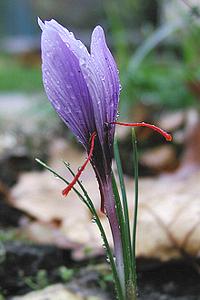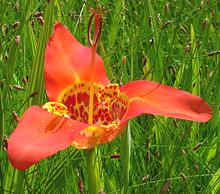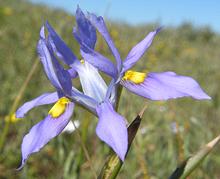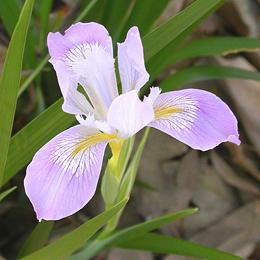
SAFARI
Users
Saffron Crocus
 [Crocus sativus]
[Crocus sativus]
The only plant in the Iris family of culinary importance, the Saffron Crocus. does not appear in nature - it is sterile, so must have been the result of human intervention. It may have originated in Bronze Age-Crete, but is now harvested as a crop from Spain through India and North Africa. The only part of the plant with culinary use is the stigmas, thread like components of the flower. These are used as a flavoring and coloring in many cuisines. They must be dried, causing chemical changes, before they are effective.
It takes 150 flowers to make 1 gram (0.035 ounce), which is about 1/2 tablespoon of threads, very loosely packed. These threads must be carefully harvested by hand. In North America, a single gram can cost between US $2.00 and $16.00 depending on size of package, grade of saffron, point of origin and what the retailer thinks he can get from his customers.
The largest producer, with something like 90% market share, is
Iran. Greece is next, then Kashmir and Morocco, with Afghanistan
rising as Kashmir falls. That available in North America is most
commonly from Spain, but Persian (Iran) is also available.
Details and Cooking.
Photo by
Gut Gimritz distributed under license Creative Commons
Attribution-ShareAlike 3.0 Unported.
Orris Root
 [German Iris; Iris germanica | Sweet Iris, Dalmation Iris;
Iris pallida]
[German Iris; Iris germanica | Sweet Iris, Dalmation Iris;
Iris pallida]
Orris root was once a common medicinal in Western medicine, but has
fallen out of use. It is still used in perfume compositions, but it's
only culinary use is as a flavoring for gin. The roots are harvested
and dried, then aged for about 5 years to develop flavor and aroma.
The photo is of German Iris, a hybrid, developed in Europe, which comes
in a number of colors.
Photo by
Bernard Haynold distributed under license Creative Commons
Attribution-ShareAlike 3.0 Unported.
Tigridia
 [Tiger Flowers, Shell Flowers; Tigridia pavonia]
[Tiger Flowers, Shell Flowers; Tigridia pavonia]
These plants, native to the region from Mexico to Chile, are grown
today for their large and unusual flowers, but the Aztecs of Mexico
also ate the roots. Sorry, I don't yet have a recipe (the Spanish
burned all that stuff).
Photo by Noah Elhardt distributed under license
Creative Commons
Attribution-ShareAlike 2.5 Generic.
Bloublommetjie-uintjie

[Moraea Fugaz]
This plant is native to South Africa, and was a favored food among the
early Dutch settlers. The bulbs (corms) were peeled and sliced, then
gently fried in butter. They have a flavor between sweet chestnuts and
potatoes.
Photo by Andrew Massyn distributed under license
Creative Commons
Attribution-ShareAlike 3.0 Unported.


